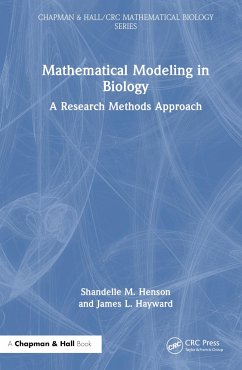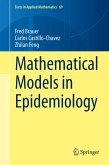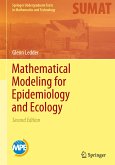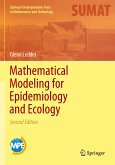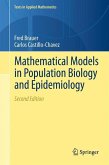- Gebundenes Buch
- Merkliste
- Auf die Merkliste
- Bewerten Bewerten
- Teilen
- Produkt teilen
- Produkterinnerung
- Produkterinnerung
Mathematical Modeling in Biology: A Research Methods Approach is a textbook written primarily for advanced mathematics and science undergraduate students and graduate-level biology students. Although the applications center on ecology, the expertise of the authors, the methodology can be imported to any other science, including social science and economics. The aim of the book, beyond being a useful aid to teaching and learning the core modeling skills needed for mathematical biology, is to encourage students to think deeply and clearly about the meaning of mathematics in science and to learn…mehr
Andere Kunden interessierten sich auch für
![Applied Engineering Mathematics Applied Engineering Mathematics]() Brian VickApplied Engineering Mathematics139,99 €
Brian VickApplied Engineering Mathematics139,99 €![Mathematical Models in Epidemiology Mathematical Models in Epidemiology]() Fred BrauerMathematical Models in Epidemiology61,99 €
Fred BrauerMathematical Models in Epidemiology61,99 €![Killer Cell Dynamics Killer Cell Dynamics]() Dominik WodarzKiller Cell Dynamics97,99 €
Dominik WodarzKiller Cell Dynamics97,99 €![Mathematical Modeling for Epidemiology and Ecology Mathematical Modeling for Epidemiology and Ecology]() Glenn LedderMathematical Modeling for Epidemiology and Ecology43,99 €
Glenn LedderMathematical Modeling for Epidemiology and Ecology43,99 €![Mathematical Modeling for Epidemiology and Ecology Mathematical Modeling for Epidemiology and Ecology]() Glenn LedderMathematical Modeling for Epidemiology and Ecology41,99 €
Glenn LedderMathematical Modeling for Epidemiology and Ecology41,99 €![Applied Mathematics for Scientists and Engineers Applied Mathematics for Scientists and Engineers]() Youssef RaffoulApplied Mathematics for Scientists and Engineers229,99 €
Youssef RaffoulApplied Mathematics for Scientists and Engineers229,99 €![Mathematical Models in Population Biology and Epidemiology Mathematical Models in Population Biology and Epidemiology]() Fred BrauerMathematical Models in Population Biology and Epidemiology67,99 €
Fred BrauerMathematical Models in Population Biology and Epidemiology67,99 €-
-
-
Mathematical Modeling in Biology: A Research Methods Approach is a textbook written primarily for advanced mathematics and science undergraduate students and graduate-level biology students. Although the applications center on ecology, the expertise of the authors, the methodology can be imported to any other science, including social science and economics. The aim of the book, beyond being a useful aid to teaching and learning the core modeling skills needed for mathematical biology, is to encourage students to think deeply and clearly about the meaning of mathematics in science and to learn significant research methods. Most importantly, it is hoped that students will experience some of the excitement of doing research. Features Minimal pre-requisites beyond a solid background in calculus, such as a calculus I course. Suitable for upper division mathematics and sciences students and graduate-level biology students. Provides sample MATLAB codes and instruction in Appendices along with datasets available on https://bit.ly/3fcLF3D
Produktdetails
- Produktdetails
- Verlag: Chapman and Hall/CRC
- Seitenzahl: 340
- Erscheinungstermin: 30. Januar 2023
- Englisch
- Abmessung: 240mm x 161mm x 23mm
- Gewicht: 675g
- ISBN-13: 9781032208213
- ISBN-10: 103220821X
- Artikelnr.: 65612108
- Herstellerkennzeichnung
- Libri GmbH
- Europaallee 1
- 36244 Bad Hersfeld
- gpsr@libri.de
- Verlag: Chapman and Hall/CRC
- Seitenzahl: 340
- Erscheinungstermin: 30. Januar 2023
- Englisch
- Abmessung: 240mm x 161mm x 23mm
- Gewicht: 675g
- ISBN-13: 9781032208213
- ISBN-10: 103220821X
- Artikelnr.: 65612108
- Herstellerkennzeichnung
- Libri GmbH
- Europaallee 1
- 36244 Bad Hersfeld
- gpsr@libri.de
Shandelle M. Henson is Professor of Mathematics and Professor of Ecology at Andrews University, Michigan, USA. She uses dynamical systems theory and bifurcation theory to study nonlinear population dynamics and the effects of climate change on marine organisms. Shandelle earned a Ph.D. in mathematics at the University of Tennessee, Knoxville and did several years of postdoctoral work at the University of Arizona. She serves as editor-in-chief of the journal Natural Resource Modeling and is a coauthor of the book Chaos in Ecology: Experimental Nonlinear Dynamics (Academic Press 2003) which documented chaotic dynamics in laboratory populations of insects. James L. Hayward is Professor Emeritus of Biology at Andrews University, Michigan, USA. He earned a Ph.D. in zoology from Washington State University, and he has studied the behaviors and population dynamics of marine birds and mammals in the Pacific Northwest of North America since he began graduate studies in 1972. In addition, Jim has studied the behavior of marine iguanas and flightless cormorants on the remote and uninhabited island of Fernandina, the westernmost island in the Galapagos. He also is a recognized expert in the fossilization of eggshell in birds and dinosaurs. Shandelle and Jim, a wife-husband research team, are widely published in both the technical and popular literature, and both have won awards for their teaching. They have applied mathematical methods to the behavioral dynamics of seabirds at Protection Island National Wildlife Refuge in the Strait of Juan de Fuca, Washington, USA since 2002. They reside in Niles, Michigan, USA and they have a daughter, son-in-law, and four grandsons. They enjoy hiking, geology, art, music, and literature.
I. Introduction to Modeling 1. Mathematical Modeling. 1.1. What You Should
Know About This Chapter. 1.2 The modeling cycle. 1.3. Biology. 1.4.
Mathematics. 1.5. Statistics. 1.6. Epistemology: How We Know. 1.7.
Exercises. 2. Avian Bone Growth: A Case Study. 2.1. What you should know
about this chapter. 2.2. Scientific Problem. 2.3. Translation into
Mathematics. 2.4. Model Parametrization. 2.5. Model Selection. 2.6. Model
Validation. 2.7. Exercises. II. Discrete-Time Models. 3. Discrete-Time
Maps. 3.1. What you should know about this chapter. 3.2. Compartmental
Model. 3.3. Linear Maps. 3.4. Nonlinear Maps. 3.5. Linearization. 3.6. The
Ricker Nonlinearity. 3.7. Exercises. 4. Chaos: Simple Rules Can Generate
Complex Results. 4.1. What you should know about this chapter. 4.2. Ricker
Model Revisited. 4.3. New Paradigms Associated from Chaos. 4.4. May's
Hypothesis. 4.5. Exercises. 5. Higher Dimensional Discrete-time Models.
5.1. What you should know about this chapter. 5.2. Intraspecific
Interactions. 5.3. Interspecific Interactions. 5.4. Example of an
Age-structured Single-Species Model. 5.5. Example of a Two-Species Model.
5.6. n-dimensional Linear Difference Equations. 5.7. Solving Linear Systems
of Difference Equations. 5.8. Nonlinear Systems. 5.9. Exercises. 6. Flour
Beetle Dynamics: A Case Study. 6.1. What you should know about this
chapter. 6.2. Flour Beetles. 6.3. Data. 6.4. Assumptions. 6.5. Alternative
Deterministic Models. 6.6. Stochastic Models. 6.7. Model Parametrization.
6.8. Model Selection. 6.9. Model Validation. 6.10. The "Hunt for Chaos"
Experiments. 6.11. Exercises. III. Continuous-time Models 7. Introduction
to Differential Equations. 7.1. What you should know about this chapter.
7.2. Compartmental Models. 7.3. Exercises. 8. Scalar Differential
Equations. 8.1. What you should know about this chapter. 8.2. Linear
Equations. 8.3. Nonlinear Equations. 8.4. Bifurcations. 8.5. Exercises. 9.
Systems of Differential Equations. 9.1. What you should know about this
chapter. 9.2. Linear Systems of ODEs and Phase Plane Analysis. 9.3.
Nonlinear Systems of ODEs. 9.4. Limit Cycles, Cycle Chains, and
Bifurcations. 9.5. Lotka-Volterra Models and Nullcline Analysis. 9.6.
Exercises. 10. Seabird Behavior: A Case Study. 10.1. What you should know
about this chapter. 10.2. The Scientific Problem. 10.3. Historical Data.
10.4. General Model. 10.5. Alternative Models. 10.6. Model Parametrization.
10.7. Model Selection. 10.8. Model Validation. 10.9. Test of a priori
predictions. 10.10. Steady-state model. 10.11. Discussion. Exercises. IV.
Regression Models. 11. Regression Models. 11.1. What You Should Know About
This Chapter. 11.2. Linear Regression. 11.3. Logistic Regression. 11.4.
Generalized Linear Models (GLMs). 11.5. Interaction Terms. 11.6. Exercises.
12. Climate Change and Seabird Cannibalism: A Case Study. 12.1. What You
Should Know About This Chapter. 12.2. The Scientific Problem. 12.3. Data.
12.4. Logistic Regression Analysis. 12.5. Model Validation. 12.6. Outcomes.
12.7. Climate Change, Cannibalism, and Reproductive Synchrony. 12.8.
Exercises. V. Appendix. A. Linear Algebra Basics. B. MATLAB: The Basics. C.
Connecting Models to Data: A Brief Summary with Sample Codes.
Know About This Chapter. 1.2 The modeling cycle. 1.3. Biology. 1.4.
Mathematics. 1.5. Statistics. 1.6. Epistemology: How We Know. 1.7.
Exercises. 2. Avian Bone Growth: A Case Study. 2.1. What you should know
about this chapter. 2.2. Scientific Problem. 2.3. Translation into
Mathematics. 2.4. Model Parametrization. 2.5. Model Selection. 2.6. Model
Validation. 2.7. Exercises. II. Discrete-Time Models. 3. Discrete-Time
Maps. 3.1. What you should know about this chapter. 3.2. Compartmental
Model. 3.3. Linear Maps. 3.4. Nonlinear Maps. 3.5. Linearization. 3.6. The
Ricker Nonlinearity. 3.7. Exercises. 4. Chaos: Simple Rules Can Generate
Complex Results. 4.1. What you should know about this chapter. 4.2. Ricker
Model Revisited. 4.3. New Paradigms Associated from Chaos. 4.4. May's
Hypothesis. 4.5. Exercises. 5. Higher Dimensional Discrete-time Models.
5.1. What you should know about this chapter. 5.2. Intraspecific
Interactions. 5.3. Interspecific Interactions. 5.4. Example of an
Age-structured Single-Species Model. 5.5. Example of a Two-Species Model.
5.6. n-dimensional Linear Difference Equations. 5.7. Solving Linear Systems
of Difference Equations. 5.8. Nonlinear Systems. 5.9. Exercises. 6. Flour
Beetle Dynamics: A Case Study. 6.1. What you should know about this
chapter. 6.2. Flour Beetles. 6.3. Data. 6.4. Assumptions. 6.5. Alternative
Deterministic Models. 6.6. Stochastic Models. 6.7. Model Parametrization.
6.8. Model Selection. 6.9. Model Validation. 6.10. The "Hunt for Chaos"
Experiments. 6.11. Exercises. III. Continuous-time Models 7. Introduction
to Differential Equations. 7.1. What you should know about this chapter.
7.2. Compartmental Models. 7.3. Exercises. 8. Scalar Differential
Equations. 8.1. What you should know about this chapter. 8.2. Linear
Equations. 8.3. Nonlinear Equations. 8.4. Bifurcations. 8.5. Exercises. 9.
Systems of Differential Equations. 9.1. What you should know about this
chapter. 9.2. Linear Systems of ODEs and Phase Plane Analysis. 9.3.
Nonlinear Systems of ODEs. 9.4. Limit Cycles, Cycle Chains, and
Bifurcations. 9.5. Lotka-Volterra Models and Nullcline Analysis. 9.6.
Exercises. 10. Seabird Behavior: A Case Study. 10.1. What you should know
about this chapter. 10.2. The Scientific Problem. 10.3. Historical Data.
10.4. General Model. 10.5. Alternative Models. 10.6. Model Parametrization.
10.7. Model Selection. 10.8. Model Validation. 10.9. Test of a priori
predictions. 10.10. Steady-state model. 10.11. Discussion. Exercises. IV.
Regression Models. 11. Regression Models. 11.1. What You Should Know About
This Chapter. 11.2. Linear Regression. 11.3. Logistic Regression. 11.4.
Generalized Linear Models (GLMs). 11.5. Interaction Terms. 11.6. Exercises.
12. Climate Change and Seabird Cannibalism: A Case Study. 12.1. What You
Should Know About This Chapter. 12.2. The Scientific Problem. 12.3. Data.
12.4. Logistic Regression Analysis. 12.5. Model Validation. 12.6. Outcomes.
12.7. Climate Change, Cannibalism, and Reproductive Synchrony. 12.8.
Exercises. V. Appendix. A. Linear Algebra Basics. B. MATLAB: The Basics. C.
Connecting Models to Data: A Brief Summary with Sample Codes.
I. Introduction to Modeling 1. Mathematical Modeling. 1.1. What You Should Know About This Chapter. 1.2 The modeling cycle. 1.3. Biology. 1.4. Mathematics. 1.5. Statistics. 1.6. Epistemology: How We Know. 1.7. Exercises. 2. Avian Bone Growth: A Case Study. 2.1. What you should know about this chapter. 2.2. Scientific Problem. 2.3. Translation into Mathematics. 2.4. Model Parametrization. 2.5. Model Selection. 2.6. Model Validation. 2.7. Exercises. II. Discrete-Time Models. 3. Discrete-Time Maps. 3.1. What you should know about this chapter. 3.2. Compartmental Model. 3.3. Linear Maps. 3.4. Nonlinear Maps. 3.5. Linearization. 3.6. The Ricker Nonlinearity. 3.7. Exercises. 4. Chaos: Simple Rules Can Generate Complex Results. 4.1. What you should know about this chapter. 4.2. Ricker Model Revisited. 4.3. New Paradigms Associated from Chaos. 4.4. May's Hypothesis. 4.5. Exercises. 5. Higher Dimensional Discrete-time Models. 5.1. What you should know about this chapter. 5.2. Intraspecific Interactions. 5.3. Interspecific Interactions. 5.4. Example of an Age-structured Single-Species Model. 5.5. Example of a Two-Species Model. 5.6. n-dimensional Linear Difference Equations. 5.7. Solving Linear Systems of Difference Equations. 5.8. Nonlinear Systems. 5.9. Exercises. 6. Flour Beetle Dynamics: A Case Study. 6.1. What you should know about this chapter. 6.2. Flour Beetles. 6.3. Data. 6.4. Assumptions. 6.5. Alternative Deterministic Models. 6.6. Stochastic Models. 6.7. Model Parametrization. 6.8. Model Selection. 6.9. Model Validation. 6.10. The "Hunt for Chaos" Experiments. 6.11. Exercises. III. Continuous-time Models 7. Introduction to Differential Equations. 7.1. What you should know about this chapter. 7.2. Compartmental Models. 7.3. Exercises. 8. Scalar Differential Equations. 8.1. What you should know about this chapter. 8.2. Linear Equations. 8.3. Nonlinear Equations. 8.4. Bifurcations. 8.5. Exercises. 9. Systems of Differential Equations. 9.1. What you should know about this chapter. 9.2. Linear Systems of ODEs and Phase Plane Analysis. 9.3. Nonlinear Systems of ODEs. 9.4. Limit Cycles, Cycle Chains, and Bifurcations. 9.5. Lotka-Volterra Models and Nullcline Analysis. 9.6. Exercises. 10. Seabird Behavior: A Case Study. 10.1. What you should know about this chapter. 10.2. The Scientific Problem. 10.3. Historical Data. 10.4. General Model. 10.5. Alternative Models. 10.6. Model Parametrization. 10.7. Model Selection. 10.8. Model Validation. 10.9. Test of a priori predictions. 10.10. Steady-state model. 10.11. Discussion. Exercises. IV. Regression Models. 11. Regression Models. 11.1. What You Should Know About This Chapter. 11.2. Linear Regression. 11.3. Logistic Regression. 11.4. Generalized Linear Models (GLMs). 11.5. Interaction Terms. 11.6. Exercises. 12. Climate Change and Seabird Cannibalism: A Case Study. 12.1. What You Should Know About This Chapter. 12.2. The Scientific Problem. 12.3. Data. 12.4. Logistic Regression Analysis. 12.5. Model Validation. 12.6. Outcomes. 12.7. Climate Change, Cannibalism, and Reproductive Synchrony. 12.8. Exercises. V. Appendix. A. Linear Algebra Basics. B. MATLAB: The Basics. C. Connecting Models to Data: A Brief Summary with Sample Codes.
I. Introduction to Modeling 1. Mathematical Modeling. 1.1. What You Should
Know About This Chapter. 1.2 The modeling cycle. 1.3. Biology. 1.4.
Mathematics. 1.5. Statistics. 1.6. Epistemology: How We Know. 1.7.
Exercises. 2. Avian Bone Growth: A Case Study. 2.1. What you should know
about this chapter. 2.2. Scientific Problem. 2.3. Translation into
Mathematics. 2.4. Model Parametrization. 2.5. Model Selection. 2.6. Model
Validation. 2.7. Exercises. II. Discrete-Time Models. 3. Discrete-Time
Maps. 3.1. What you should know about this chapter. 3.2. Compartmental
Model. 3.3. Linear Maps. 3.4. Nonlinear Maps. 3.5. Linearization. 3.6. The
Ricker Nonlinearity. 3.7. Exercises. 4. Chaos: Simple Rules Can Generate
Complex Results. 4.1. What you should know about this chapter. 4.2. Ricker
Model Revisited. 4.3. New Paradigms Associated from Chaos. 4.4. May's
Hypothesis. 4.5. Exercises. 5. Higher Dimensional Discrete-time Models.
5.1. What you should know about this chapter. 5.2. Intraspecific
Interactions. 5.3. Interspecific Interactions. 5.4. Example of an
Age-structured Single-Species Model. 5.5. Example of a Two-Species Model.
5.6. n-dimensional Linear Difference Equations. 5.7. Solving Linear Systems
of Difference Equations. 5.8. Nonlinear Systems. 5.9. Exercises. 6. Flour
Beetle Dynamics: A Case Study. 6.1. What you should know about this
chapter. 6.2. Flour Beetles. 6.3. Data. 6.4. Assumptions. 6.5. Alternative
Deterministic Models. 6.6. Stochastic Models. 6.7. Model Parametrization.
6.8. Model Selection. 6.9. Model Validation. 6.10. The "Hunt for Chaos"
Experiments. 6.11. Exercises. III. Continuous-time Models 7. Introduction
to Differential Equations. 7.1. What you should know about this chapter.
7.2. Compartmental Models. 7.3. Exercises. 8. Scalar Differential
Equations. 8.1. What you should know about this chapter. 8.2. Linear
Equations. 8.3. Nonlinear Equations. 8.4. Bifurcations. 8.5. Exercises. 9.
Systems of Differential Equations. 9.1. What you should know about this
chapter. 9.2. Linear Systems of ODEs and Phase Plane Analysis. 9.3.
Nonlinear Systems of ODEs. 9.4. Limit Cycles, Cycle Chains, and
Bifurcations. 9.5. Lotka-Volterra Models and Nullcline Analysis. 9.6.
Exercises. 10. Seabird Behavior: A Case Study. 10.1. What you should know
about this chapter. 10.2. The Scientific Problem. 10.3. Historical Data.
10.4. General Model. 10.5. Alternative Models. 10.6. Model Parametrization.
10.7. Model Selection. 10.8. Model Validation. 10.9. Test of a priori
predictions. 10.10. Steady-state model. 10.11. Discussion. Exercises. IV.
Regression Models. 11. Regression Models. 11.1. What You Should Know About
This Chapter. 11.2. Linear Regression. 11.3. Logistic Regression. 11.4.
Generalized Linear Models (GLMs). 11.5. Interaction Terms. 11.6. Exercises.
12. Climate Change and Seabird Cannibalism: A Case Study. 12.1. What You
Should Know About This Chapter. 12.2. The Scientific Problem. 12.3. Data.
12.4. Logistic Regression Analysis. 12.5. Model Validation. 12.6. Outcomes.
12.7. Climate Change, Cannibalism, and Reproductive Synchrony. 12.8.
Exercises. V. Appendix. A. Linear Algebra Basics. B. MATLAB: The Basics. C.
Connecting Models to Data: A Brief Summary with Sample Codes.
Know About This Chapter. 1.2 The modeling cycle. 1.3. Biology. 1.4.
Mathematics. 1.5. Statistics. 1.6. Epistemology: How We Know. 1.7.
Exercises. 2. Avian Bone Growth: A Case Study. 2.1. What you should know
about this chapter. 2.2. Scientific Problem. 2.3. Translation into
Mathematics. 2.4. Model Parametrization. 2.5. Model Selection. 2.6. Model
Validation. 2.7. Exercises. II. Discrete-Time Models. 3. Discrete-Time
Maps. 3.1. What you should know about this chapter. 3.2. Compartmental
Model. 3.3. Linear Maps. 3.4. Nonlinear Maps. 3.5. Linearization. 3.6. The
Ricker Nonlinearity. 3.7. Exercises. 4. Chaos: Simple Rules Can Generate
Complex Results. 4.1. What you should know about this chapter. 4.2. Ricker
Model Revisited. 4.3. New Paradigms Associated from Chaos. 4.4. May's
Hypothesis. 4.5. Exercises. 5. Higher Dimensional Discrete-time Models.
5.1. What you should know about this chapter. 5.2. Intraspecific
Interactions. 5.3. Interspecific Interactions. 5.4. Example of an
Age-structured Single-Species Model. 5.5. Example of a Two-Species Model.
5.6. n-dimensional Linear Difference Equations. 5.7. Solving Linear Systems
of Difference Equations. 5.8. Nonlinear Systems. 5.9. Exercises. 6. Flour
Beetle Dynamics: A Case Study. 6.1. What you should know about this
chapter. 6.2. Flour Beetles. 6.3. Data. 6.4. Assumptions. 6.5. Alternative
Deterministic Models. 6.6. Stochastic Models. 6.7. Model Parametrization.
6.8. Model Selection. 6.9. Model Validation. 6.10. The "Hunt for Chaos"
Experiments. 6.11. Exercises. III. Continuous-time Models 7. Introduction
to Differential Equations. 7.1. What you should know about this chapter.
7.2. Compartmental Models. 7.3. Exercises. 8. Scalar Differential
Equations. 8.1. What you should know about this chapter. 8.2. Linear
Equations. 8.3. Nonlinear Equations. 8.4. Bifurcations. 8.5. Exercises. 9.
Systems of Differential Equations. 9.1. What you should know about this
chapter. 9.2. Linear Systems of ODEs and Phase Plane Analysis. 9.3.
Nonlinear Systems of ODEs. 9.4. Limit Cycles, Cycle Chains, and
Bifurcations. 9.5. Lotka-Volterra Models and Nullcline Analysis. 9.6.
Exercises. 10. Seabird Behavior: A Case Study. 10.1. What you should know
about this chapter. 10.2. The Scientific Problem. 10.3. Historical Data.
10.4. General Model. 10.5. Alternative Models. 10.6. Model Parametrization.
10.7. Model Selection. 10.8. Model Validation. 10.9. Test of a priori
predictions. 10.10. Steady-state model. 10.11. Discussion. Exercises. IV.
Regression Models. 11. Regression Models. 11.1. What You Should Know About
This Chapter. 11.2. Linear Regression. 11.3. Logistic Regression. 11.4.
Generalized Linear Models (GLMs). 11.5. Interaction Terms. 11.6. Exercises.
12. Climate Change and Seabird Cannibalism: A Case Study. 12.1. What You
Should Know About This Chapter. 12.2. The Scientific Problem. 12.3. Data.
12.4. Logistic Regression Analysis. 12.5. Model Validation. 12.6. Outcomes.
12.7. Climate Change, Cannibalism, and Reproductive Synchrony. 12.8.
Exercises. V. Appendix. A. Linear Algebra Basics. B. MATLAB: The Basics. C.
Connecting Models to Data: A Brief Summary with Sample Codes.
I. Introduction to Modeling 1. Mathematical Modeling. 1.1. What You Should Know About This Chapter. 1.2 The modeling cycle. 1.3. Biology. 1.4. Mathematics. 1.5. Statistics. 1.6. Epistemology: How We Know. 1.7. Exercises. 2. Avian Bone Growth: A Case Study. 2.1. What you should know about this chapter. 2.2. Scientific Problem. 2.3. Translation into Mathematics. 2.4. Model Parametrization. 2.5. Model Selection. 2.6. Model Validation. 2.7. Exercises. II. Discrete-Time Models. 3. Discrete-Time Maps. 3.1. What you should know about this chapter. 3.2. Compartmental Model. 3.3. Linear Maps. 3.4. Nonlinear Maps. 3.5. Linearization. 3.6. The Ricker Nonlinearity. 3.7. Exercises. 4. Chaos: Simple Rules Can Generate Complex Results. 4.1. What you should know about this chapter. 4.2. Ricker Model Revisited. 4.3. New Paradigms Associated from Chaos. 4.4. May's Hypothesis. 4.5. Exercises. 5. Higher Dimensional Discrete-time Models. 5.1. What you should know about this chapter. 5.2. Intraspecific Interactions. 5.3. Interspecific Interactions. 5.4. Example of an Age-structured Single-Species Model. 5.5. Example of a Two-Species Model. 5.6. n-dimensional Linear Difference Equations. 5.7. Solving Linear Systems of Difference Equations. 5.8. Nonlinear Systems. 5.9. Exercises. 6. Flour Beetle Dynamics: A Case Study. 6.1. What you should know about this chapter. 6.2. Flour Beetles. 6.3. Data. 6.4. Assumptions. 6.5. Alternative Deterministic Models. 6.6. Stochastic Models. 6.7. Model Parametrization. 6.8. Model Selection. 6.9. Model Validation. 6.10. The "Hunt for Chaos" Experiments. 6.11. Exercises. III. Continuous-time Models 7. Introduction to Differential Equations. 7.1. What you should know about this chapter. 7.2. Compartmental Models. 7.3. Exercises. 8. Scalar Differential Equations. 8.1. What you should know about this chapter. 8.2. Linear Equations. 8.3. Nonlinear Equations. 8.4. Bifurcations. 8.5. Exercises. 9. Systems of Differential Equations. 9.1. What you should know about this chapter. 9.2. Linear Systems of ODEs and Phase Plane Analysis. 9.3. Nonlinear Systems of ODEs. 9.4. Limit Cycles, Cycle Chains, and Bifurcations. 9.5. Lotka-Volterra Models and Nullcline Analysis. 9.6. Exercises. 10. Seabird Behavior: A Case Study. 10.1. What you should know about this chapter. 10.2. The Scientific Problem. 10.3. Historical Data. 10.4. General Model. 10.5. Alternative Models. 10.6. Model Parametrization. 10.7. Model Selection. 10.8. Model Validation. 10.9. Test of a priori predictions. 10.10. Steady-state model. 10.11. Discussion. Exercises. IV. Regression Models. 11. Regression Models. 11.1. What You Should Know About This Chapter. 11.2. Linear Regression. 11.3. Logistic Regression. 11.4. Generalized Linear Models (GLMs). 11.5. Interaction Terms. 11.6. Exercises. 12. Climate Change and Seabird Cannibalism: A Case Study. 12.1. What You Should Know About This Chapter. 12.2. The Scientific Problem. 12.3. Data. 12.4. Logistic Regression Analysis. 12.5. Model Validation. 12.6. Outcomes. 12.7. Climate Change, Cannibalism, and Reproductive Synchrony. 12.8. Exercises. V. Appendix. A. Linear Algebra Basics. B. MATLAB: The Basics. C. Connecting Models to Data: A Brief Summary with Sample Codes.
"Without hesitation, we highly recommend this book for Mathematics and Science Undergraduate Students and Graduate-Level Biology Students as well as researchers who are interested in biological research using a Mathematical Modeling approach. Apart from providing information for readers, this book is also equipped with exercises in almost every chapter to train readers to understand the contents of the book and this book is also equipped with various case studies that can be studied to understand the concepts of Mathematical Modeling in Biology. We greatly appreciate the authors who have contributed to writing this book which is the first edition of CRC Press for the Mathematical Biology Series. The enormous potential of Mathematical Modeling as a statistical approach in research methods can be predicted that this book will become a fundamental need for current and future research in the field of biology and several related fields."
- Technometrics
- Technometrics

